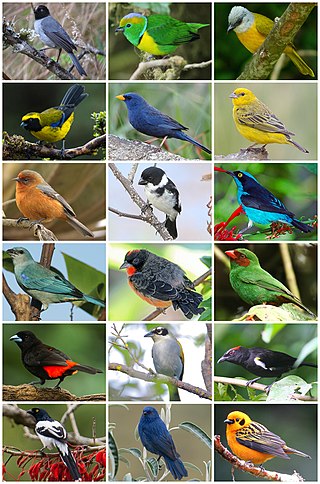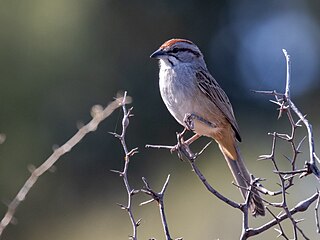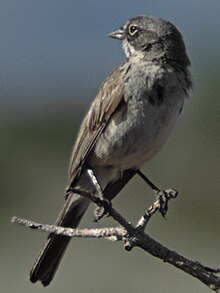
The buntings are a group of Old World passerine birds forming the genus Emberiza, the only genus in the family Emberizidae. The family contains 44 species. They are seed-eating birds with stubby, conical bills.

The New World warblers or wood-warblers are a group of small, often colorful, passerine birds that make up the family Parulidae and are restricted to the New World. The family contains 120 species. They are not closely related to Old World warblers or Australian warblers. Most are arboreal, but some, like the ovenbird and the two waterthrushes, are primarily terrestrial. Most members of this family are insectivores.

The tanagers comprise the bird family Thraupidae, in the order Passeriformes. The family has a Neotropical distribution and is the second-largest family of birds. It represents about 4% of all avian species and 12% of the Neotropical birds.

The American tree sparrow, also known as the winter sparrow, is a medium-sized New World sparrow.

Pipilo is a genus of birds in the American sparrow family Passerellidae. It is one of two genera containing birds with the common name towhee.

The genus Spizella is a group of American sparrows in the family Passerellidae.

The black-faced grassquit is a small bird. It is recognized as a tanager closely related to Darwin's finches. It breeds in the West Indies except Cuba, on Tobago but not Trinidad, and along the northern coasts of Colombia and Venezuela.

The nine-primaried oscines is a group of bird families in the suborder Passeri (oscines) of the Passeriformes. The composition of the group has changed since the term was introduced but is now considered to consist of seven major families—Fringillidae, Emberizidae, Cardinalidae, Thraupidae, Passerellidae, Parulidae and Icteridae—plus some small families. When Fringillidae is omitted the remaining six families are referred to as the "New World" nine-primaried oscines.

The sagebrush sparrow is a medium-sized sparrow of the western United States and northwestern Mexico. It used to be placed in the genus Amphispiza, but evidence from 2007 and 2009 suggested it be placed in its own genus.

Passerida is, under the Sibley-Ahlquist taxonomy, one of two parvorders contained within the suborder Passeri. While more recent research suggests that its sister parvorder, Corvida, is not a monophyletic grouping, the Passerida as a distinct clade are widely accepted.

New World sparrows are a group of mainly New World passerine birds, forming the family Passerellidae. They are seed-eating birds with conical bills, brown or gray in color, and many species have distinctive head patterns.

Phrygilus is a genus of mainly Andean seed-eating tanagers commonly known as sierra finches. Phrygilos means finch in Ancient Greek. Traditionally classified in the bunting and American sparrow family Emberizidae, more recent studies have shown them to belong in the Thraupidae.

The Chaco sparrow, formerly known as the stripe-capped sparrow, is a species of bird in the family Passerellidae. It is found in Argentina and Paraguay.

Loxigilla is a genus of passerine birds in the tanager family Thraupidae. The two species are both endemic to the Lesser Antilles.

Peucaea is a genus of American sparrows. The species in this genus used to be included in the genus Aimophila.

Richard Charles Banks was an American author, ornithologist and Emeritus Research Zoologist on staff with the Patuxent Wildlife Research Center run by the U.S. Geological Survey and stationed at the Smithsonian Institution in Washington, D.C. He is the founder of the Ornithological Council and known for his study of the migratory systems, patterns, and geographic variations of North American birds, primarily focusing on the research and analysis of Greater White-fronted Geese.
Sage sparrow was the name of a species of sparrow that has since been reclassified as two species:

Bell's sparrow is a medium-sized sparrow of the western United States and northwestern Mexico. It used to be placed in the genus Amphispiza, but recent evidence suggested it be placed in its own genus.

Emberizoidea is a superfamily of passerines that are referred to as the New World nine-primaried oscines that includes majority of endemics which are exclusive to the New World. Nearly 892 species belong to this group as it includes buntings, American sparrows, the New World blackbirds, the parulid warblers, the cardinals, and the tanagers.

Driophlox is a genus of passerine birds in the family Cardinalidae. The four species placed in this genus were formerly placed with the red-crowned ant tanager in the genus Habia.























